Mountain Law: What Does It Change For Your Vehicle?
A new winter equipment requirement will come into force on 1 November 2021 in mountainous areas. In order to limit traffic jams on the roads and to ensure the safety of users, the Mountain Law requires that you equip your car with winter tires or keep chains in your trunk during the winter period in certain municipalities. Here is everything you need to know about this new obligation.
Why this new obligation?
The obligation of winter equipment that will come into force on November 1, 2021 was decided in application of the Mountain Law II of December 28, 2016.
The corresponding decree was published in the Official Journal on 18 October 2020.
This measure is intended to enhance road safety on mountain roads.
What equipment is required?
In the areas concerned by this new obligation, light vehicles, commercial vehicles and motor homes will have to :
- either carry metal or textile snow chains in their trunks to equip at least 2 driving wheels
- or be equipped with four winter tyres (also called snow tyres) or four four-season tyres.
In practice, this means that you are not obliged to change your tyres for snow tyres or four-season tyres if you have a pair of snow chains or socks in your boot.
To be noted: for the next three winters, from 2021 to 2024, the designation 'winter tyres' will cover all tyres identified by one of the M+S, M.S or M&S markings or by the joint presence of the alpine symbol marking (recognised as 3PMSF for 3 Peak Mountain Snow Flake) and one of the M+S, M.S or M&S markings.
As of November 1, 2024, the winter tire designation will only cover tires identified by the presence of both the alpine symbol marking and one of the M+S, M.S or M&S markings.
Which vehicles are affected?
The winter equipment requirement applies to light vehicles, commercial vehicles and motor homes.
Coaches, buses and heavy goods vehicles without trailers or semi-trailers are also subject to this new obligation.
However, this measure does not apply to vehicles equipped with studded tires.
In addition, heavy goods vehicles with a trailer or semi-trailer will have to have snow chains to equip at least 2 driving wheels, even if they are equipped with winter tires.
In which geographical areas?
The obligation to equip one's vehicle with winter tires or to keep chains in one's trunk will concern only certain communes, during the winter period, i.e. from November 1 to March 31.
It is up to the prefects of the 48 departments located in mountainous areas such as the Alps, Corsica, the Massif Central, the Jura Massif, the Pyrenees and the Vosges to draw up the list of communes concerned.
This list will be drawn up after consultation with local elected representatives.
A provisional map of the geographical areas concerned is already available on the road safety website (see link below).
It will be updated and then made definitive as prefectural decisions are made.
Exemptions may also be defined by order of the prefect for certain road sections and certain relief routes.
Will the signage be adapted?
From November 1, 2021, a new signage will be gradually implemented on mountain roads.
It will be used to indicate to motorists the entrances and exits of areas where the winter equipment requirement applies.
To be noted: in mountainous areas, it is in any case advisable to equip yourself with winter or four-season tires, as on many roads these snow tires AND chains are both mandatory.
As far as prices are concerned, you should expect to pay around €30 for a pair of chains or socks and between €400 and €1,200 for 4 winter tyres.
What are the penalties?
Violators of this new obligation are liable to a fine of 135 €.
However, as this is a new obligation, a tolerance will apply during the winter of 2021.
Any failures to comply with this obligation to keep snow chains in their trunks or to equip their vehicles with winter tyres in the departments concerned will not be sanctioned this winter.










